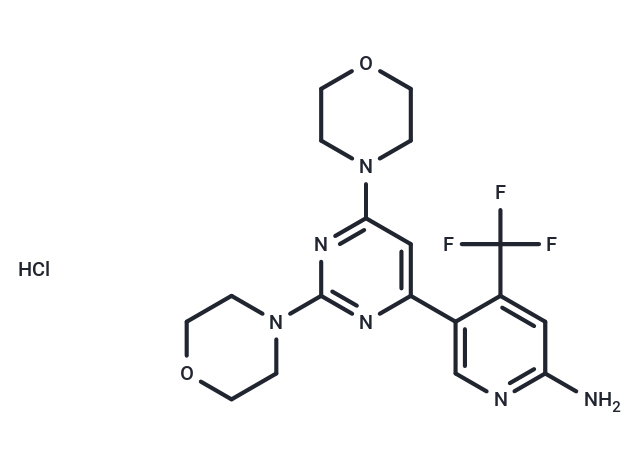Shopping Cart
Remove All Your shopping cart is currently empty
Your shopping cart is currently empty
Buparlisib Hydrochloride (BKM120 HCl) is a specific and orally bioavailable pan-class I PI3K inhibitor that competitively inhibits PI3K/AKT kinase at the nanomolar level and suppresses cancer cell growth, making it suitable for studying breast cancer, glioblastoma, and solid tumours.

| Pack Size | Price | USA Warehouse | Global Warehouse | Quantity |
|---|---|---|---|---|
| 2 mg | $36 | In Stock | In Stock | |
| 5 mg | $58 | - | In Stock | |
| 10 mg | $88 | - | In Stock | |
| 25 mg | $118 | - | In Stock | |
| 1 mL x 10 mM (in DMSO) | $69 | - | In Stock |
| Description | Buparlisib Hydrochloride (BKM120 HCl) is a specific and orally bioavailable pan-class I PI3K inhibitor that competitively inhibits PI3K/AKT kinase at the nanomolar level and suppresses cancer cell growth, making it suitable for studying breast cancer, glioblastoma, and solid tumours. |
| Targets&IC50 | p110α-E545K:99 nM, p110γ:262 nM, p110α:52 nM, mTOR:4.6 μM, p110β:166 nM, p110δ:116 nM, p110α-H1047R:58 nM, Vps34:2.4 μM |
| In vitro | MM cell lines were treated with Buparlisib Hydrochloride (10 μM, 24 hours) to observe its effects on cells. Results: Buparlisib Hydrochloride treatment resulted in growth inhibition and apoptosis of MM cells in a dose- and time-dependent manner. The IC50 values for ARP-1, ARK, and MM.1R were between 1 and 10 μM, the IC50 value for MM.1S was <1 μM, and the IC50 value for U266 was between 10 and 100 μM. Buparlisib Hydrochloride treatment resulted in growth inhibition and apoptosis of MM cells in a dose- and time-dependent manner. [2] |
| In vivo | Methods: Abcg2−/−, Abcb1a/b−/−, and Abcb1a/b;Abcg2−/− mice were treated with Buparlisib Hydrochloride (2 mg/kg, intravenously, 1 hour) to investigate whether P-gp and BCRP could attenuate Buparlisib Hydrochloride brain penetration in vivo. Results: P-gp and BCRP did not limit Buparlisib Hydrochloride brain penetration in vivo. Brain-to-plasma ratios were between 1.5 and 2 for all strains, indicating that Buparlisib Hydrochloride exhibited excellent brain penetration. [3] |
| Synonyms | NVP-BKM120 Hydrochloride, BKM120 Hydrochloride |
| Molecular Weight | 446.85 |
| Formula | C18H22ClF3N6O2 |
| Cas No. | 1312445-63-8 |
| Smiles | Cl.FC(F)(F)C1=CC(=NC=C1C=2N=C(N=C(C2)N3CCOCC3)N4CCOCC4)N |
| Relative Density. | 1.31g/cm3 |
| Color | White |
| Appearance | Solid |
| Storage | store at low temperature | Powder: -20°C for 3 years | In solvent: -80°C for 1 year | Shipping with blue ice/Shipping at ambient temperature. |
| Solubility Information | DMSO: ≥ 40 mg/mL, Sonication is recommended. |
| In Vivo Formulation | 10% DMSO+40% PEG300+5% Tween 80+45% Saline: 2 mg/mL (4.48 mM), Sonication is recommended. Please add the solvents sequentially, clarifying the solution as much as possible before adding the next one. Dissolve by heating and/or sonication if necessary. Working solution is recommended to be prepared and used immediately. The formulation provided above is for reference purposes only. In vivo formulations may vary and should be modified based on specific experimental conditions. |
| Size | Quantity | Unit Price | Amount | Operation |
|---|

Copyright © 2015-2025 TargetMol Chemicals Inc. All Rights Reserved.